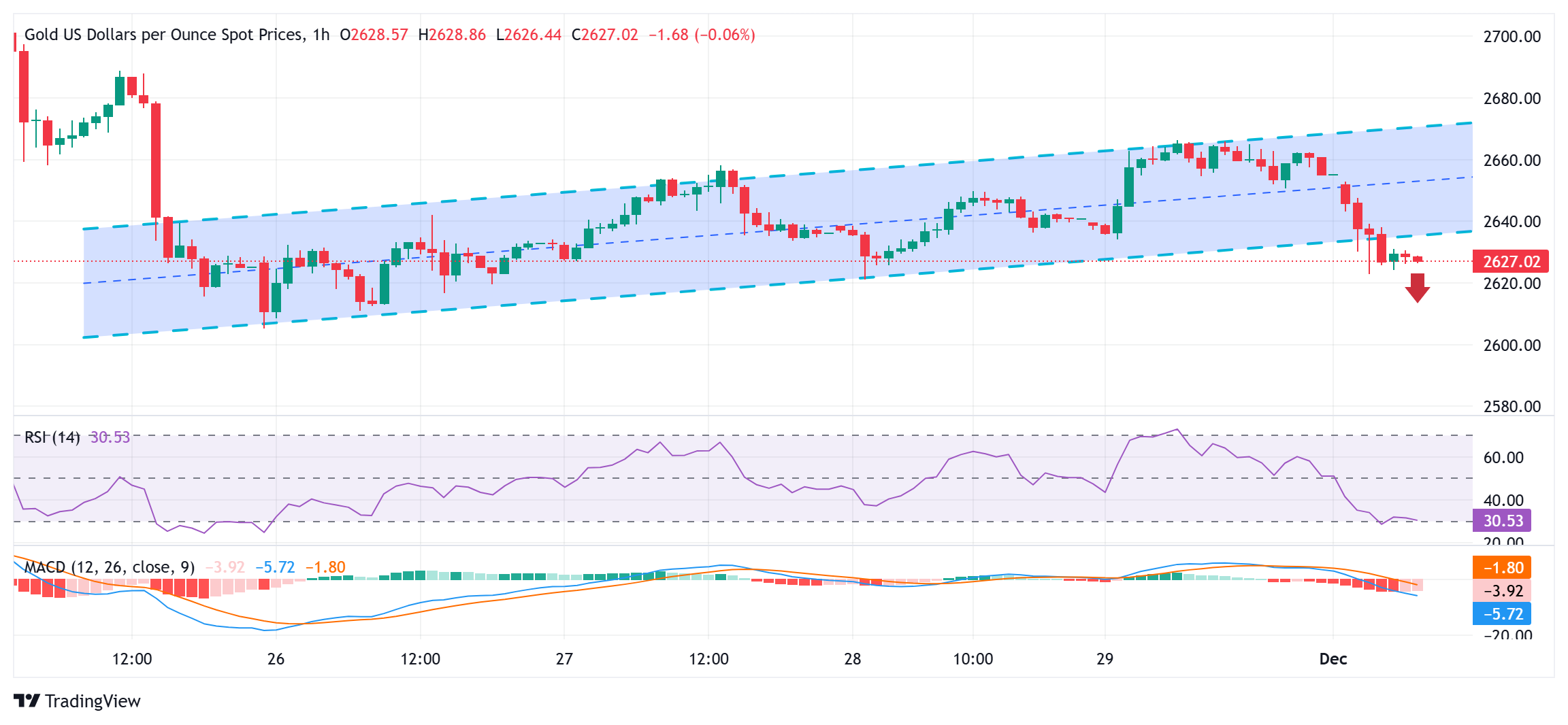The Morning Market Update

- Gold price meets with heavy supply on Monday and snaps a four-day winning streak.
- Rebounding US bond yields help revive the USD demand and weigh on the commodity.
- Trade war concerns and geopolitical risks help limit losses for the safe-haven XAU/USD.
Gold price (XAU/USD) recovers slightly from the daily swing low, albeit retains its intraday negative bias through the early European session and currently trades around the $2,630 region. Expectations that US President-elect Donald Trump’s tariff plans could reignite inflation and limit the scope for the Federal Reserve (Fed) to cut interest rates trigger a fresh leg up in the US Treasury bond yields. This turns out to be a key factor driving flows away from the non-yielding yellow metal.
Meanwhile, rebounding US bond yields assist the US Dollar (USD) in staging a solid recovery from a nearly three-week low touched last Friday, which further undermines demand for the Gold price. That said, trade war concerns, geopolitical tension and a softer risk tone offer some support to the safe-haven XAU/USD. Traders might also refrain from placing aggressive bets ahead of important US macro data scheduled at the beginning of a new month, including the Nonfarm Payrolls (NFP) report.
Gold price finds some support from trade war fears, geopolitical tensions and a softer risk tone
- The US Dollar staged a goodish recovery from its lowest level since November 12 touched last Friday amid a fresh leg up in the US Treasury bond yields and weighs on the Gold price at the start of a new week/month.
- Investors seem convinced that US President-elect Donald Trump’s tariff plans could trigger the second wave of trade wars and push consumer prices higher, forcing the Federal Reserve to stop cutting rates.
- In a critical post over the weekend, Trump threatened a 100% tariff on BRICS nations – Brazil, Russia, India, China, and South Africa – if they replace the USD with another currency for international transactions.
- Ukrainian President Volodymyr Zelenskyy has stated that he is willing to give up occupied Ukrainian territory to Russia, albeit with some conditions, in order to reach a ceasefire agreement and achieve peace.
- Russian and Syrian jets have carried out a series of air strikes on Syrian rebels led by the jihadi group Hayat Tahrir al-Sham, who took over most of Aleppo in a shock offensive on Saturday and entered the city of Hama.
- China’s official Manufacturing Purchasing Managers’ Index (PMI) edged up to 50.3 in November from 50.2, while the NBS Non-Manufacturing PMI eased to 50.0 during the reported month from October’s 50.2.
- China’s Caixin Manufacturing Purchasing Managers’ Index (PMI) jumped to 51.5 in November after recording 50.3 in October amid hopes that the government will introduce more stimulus to bolster domestic demand.
- This week’s important US macroeconomic releases, starting with the ISM Manufacturing PMI later this Monday, will be looked for interest rate cuts, which, in turn, will drive the USD and the non-yielding XAU/USD.
Gold price could attract fresh sellers and remain capped near $2,642-2,643 support breakpoint

From a technical perspective, an intraday slide below the lower boundary of a nearly one-week-old descending channel could be seen as a key trigger for bearish traders. Moreover, oscillators on daily/4-hour charts have again started gaining negative traction and suggest that the path of least resistance for the Gold price is to the downside. Hence, a subsequent fall back towards last week’s swing low, around the $2,605 region, looks like a distinct possibility. Some follow-through selling below the $2,600 mark would expose the 100-day Simple Moving Average (SMA), currently pegged near the $2,575 region.
On the flip side, the ascending trend-channel support breakpoint, around the $2,642-2,643 area, might now act as an immediate hurdle ahead of the $2,652 static resistance and last Friday’s swing high, around the $2,665 region. Some follow-through buying should allow the Gold price to reclaim the $2,700 round-figure mark and extend the positive move further towards the $2,721-2,722 supply zone. The latter should act as a pivotal point, which if cleared decisively will suggest that the recent corrective decline from the all-time peak touched in October has run its course and pave the way for a further appreciating move.





